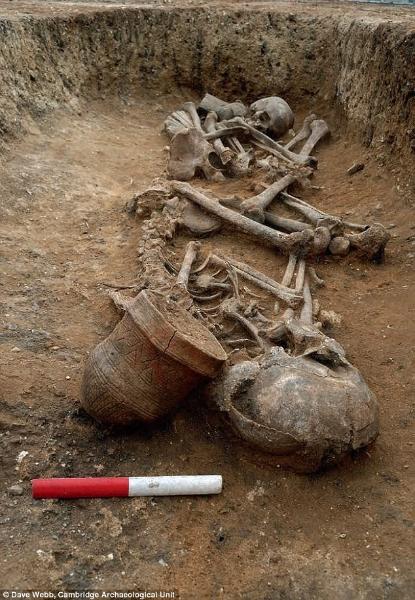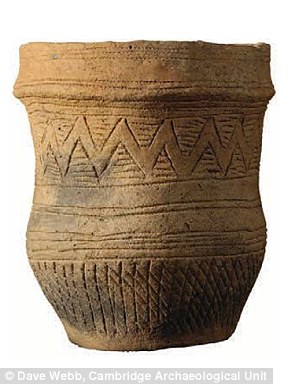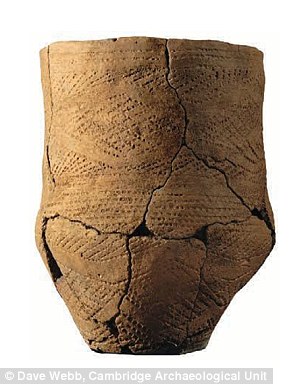Evidence from Trumpington excavations incorporated in archaeology research project about Beaker People
February 2018

Skeletons excavated from the archaeological excavations on Trumpington Meadows and Clay Farm have been used in a major research project about the settlement of Britain by the Neolithic Beaker people who started to settle in Britain around 2500 BC.
This wave of migration from northern Europe to Britain started around 2500 BC and largely supplanted the indigenous people (the builders of Stonehenge, etc.). The researchers have analysed 155 skeletons, including ‘an enigmatic double burial from Trumpington of a teenage boy and girl’ [The Guardian] and two burials from Clay Farm. The reference to the double burial is to bodies found when the Neolithic round barrow was excavated in 2010 in the area where Trumpington Meadows Primary School has been built (see the reports on the Local History Group site visit in May 2011 and the meeting in April 2013).
The original article is in Nature, “The Beaker phenomenon and the genomic transformation of northwest Europe”, Nature, doi:10.1038/nature25738, 21 February 2018 (see online summary). There is no specific reference to Trumpington in the body of the text (which is relatively short and analytical) but the list of UK sites in a table has entries for Trumpington Meadows and Clay Farm.
The University of Cambridge and Oxford Archaeology websites had notes about the local connection.
University Department of Archaeology. The text included: “Aside from contributing a number of later, Bronze Age-individual samples, seven of the Beaker burials analysed from Britain were provided by the Cambridge Archaeological Unit, University of Cambridge. The most immediate of these is from a double grave at Trumpington Meadows, near the riverside just south of the village. Laid head-to-toe, one individual was a 16–18 year-old female, with the other a 17–20 year-old male. The pair date between 2000 and 1950 BC and, characteristic of the period, each was accompanied by a fineware beaker. Although what caused the pair’s death is unknown, their genetic analysis shows – aside from their direct near-Continental links – that, sharing mitochondrial DNA, they were second or third degree relatives.
Oxford Archaeology (OAE): “Among the sites that have contributed data are several excavated by Oxford Archaeology, including Yarnton and Radley in Oxfordshire, Eton Rowing Course in Buckinghamshire, Melton Quarry in the East Riding of Yorkshire, and Clay Farm in Cambridgeshire.”



Newspapers reports: